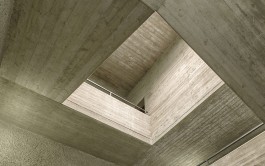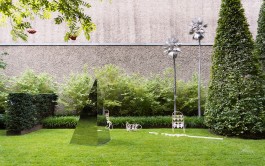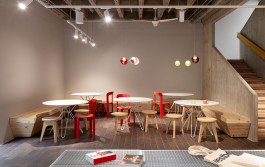
















1/17
2/17
3/17
4/17
5/17
6/17
7/17
8/17
9/17
10/17
12/17
16/17
17/17
When the Catholic parish St. Agnes was founded in 1925 in Kreuzberg, Berlin’s largest and most famous church, the cathedral on Museum Island with its impressive patina domes located just across from the newly built city palace, had only been there for twenty years. The Protestant, Prussian Emperor Wilhelm II had the cathedral built for himself and his predominantly evangelical subjects in the capital.
The parish of St. Agnes had to content with a much less imposing and spectacular place of worship. In the years following its foundation, it made do with a drafty makeshift building: converted riding stables from the time of Frederick the Great in Hollmannstraße, near today’s Lindenstaße. This area of Berlin, situated between Hallesches Tor, Gitschiner Straße, and Moritzplatz, was the southern prolongation of the city center and home to the court of appeal and the newspaper district until the end of World War II. It is still the geographical center of Berlin today.
Yet the war changed the cityscape dramatically, and in particular Kreuzberg. The bombs left little of the western Luisenstadt and its dense residential area and the adjoining southern Friedrichstadt, and by February 1945 the entire area was razed to the ground. The makeshift church of St. Agnes did not survive the war either, and only 400 remained of the 4,000 parish members.
The former residential area lay fallow for almost fifteen years. It was only in the late 1950s that the city started building it up again. Specifically, a rather pragmatic, unpretentious housing estate of eight to ten-storey, occasionally sixteen-storey, detached buildings named the Spring Project was built between Alte Jakobstraße and Alexandrinenstraße by 1962, according to the design of the architects Wils Ebert and Klaus Müller-Rehm.
In the meantime, the parish of St. Agnes had slowly but steadily grown, and in 1964 plans were drawn up to construct the long-awaited church. By this time, the architect, urban planner, and later president of the Akademie der Künste Werner Düttmann had been appointed Berlin’s director of urban development (1960–66), and the new chief planning official of the city took it upon himself to realize a new, modernist parish center in Alexandrinenstraße by 1967.
The built towering monolithic structure was quickly embraced by members of the parish and citizens alike and became evermore popular, as the architecture critic Niklas Maak (Frankfurter Allgemeine Zeitung) explained in an article on Düttmann for KÖNIG MAGAZINE: “The churchgoers found something here that they missed in modern architecture. The sense of space and the mystical atmosphere of old Roman churches.”
However, like in most other large cities, the number of parish members decreased dramatically again around the turn of the millennium, forcing the diocesan bishop of Berlin to merge several parishes as well as to close, desacralize, and lease churches. In western Kreuzberg, the parishes affected were St. Bonifatius, St. Agnes, and St. Johannes. St. Agnes had to be given up completely in 2005 and its parish activities were moved to St. Bonifatius. The organ that presided over its church gallery for almost forty years today stands in St. Bonifatius.
After some years of interim use, Johann and Lena König acquired the parish center of St. Agnes from the diocesan bishop of Berlin in 2011, as directors of the St. Agnes Immobilien- und Verwaltungsgesellschaft mbH in 2012.